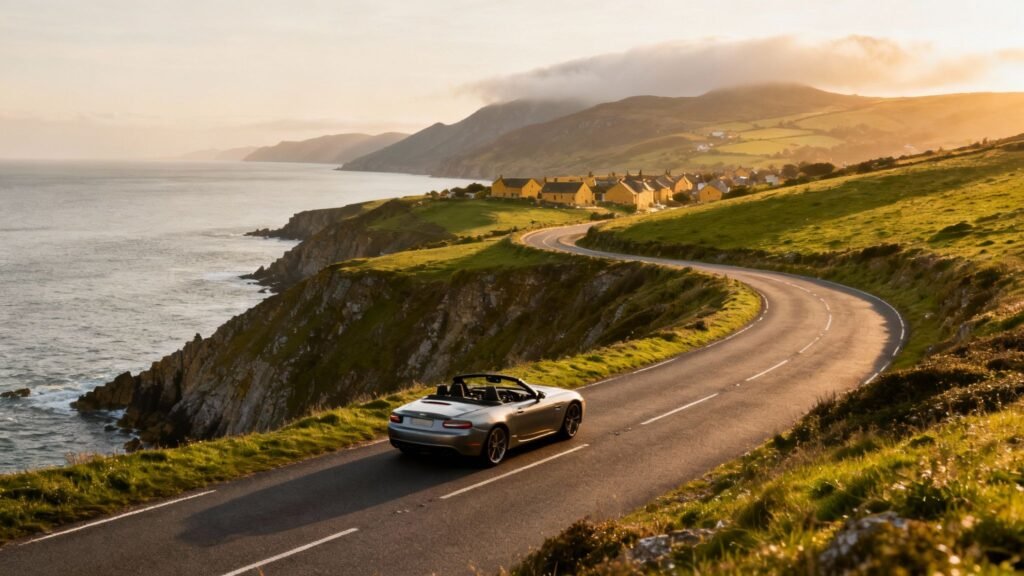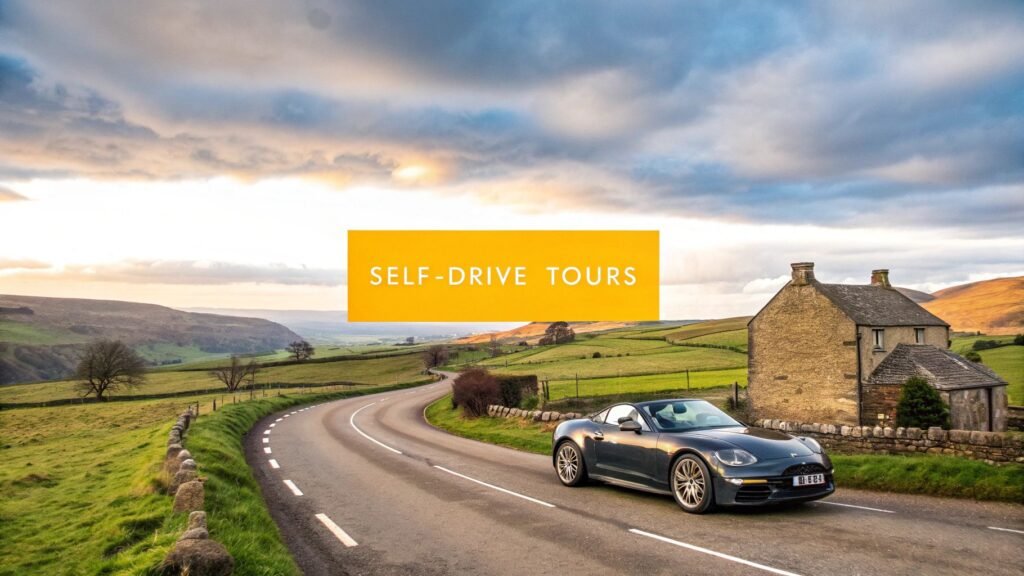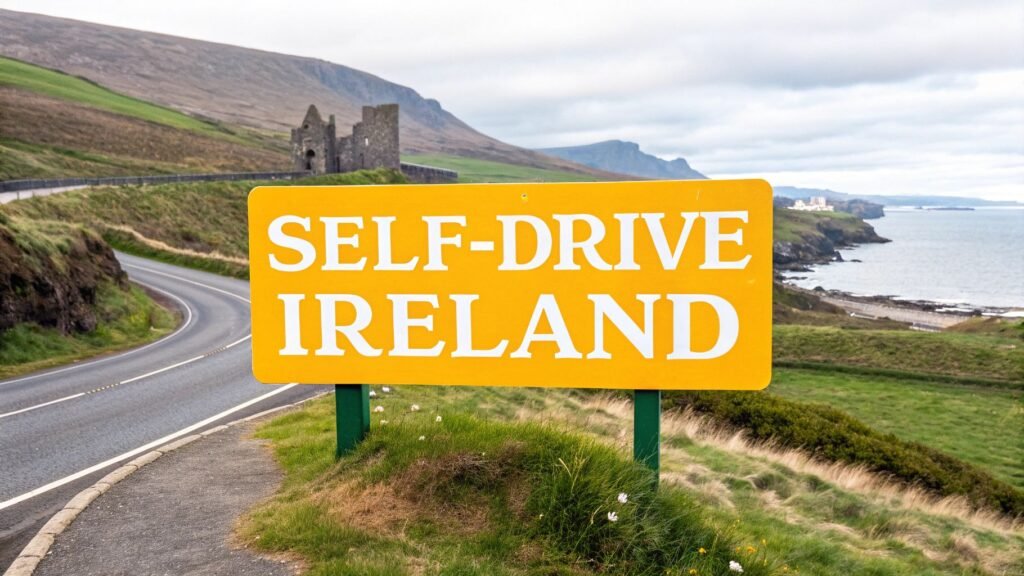The UK is a treasure trove of spectacular landscapes, best explored from behind the wheel. From the windswept grandeur of the Scottish Highlands to the quaint, honey-coloured villages of the Cotswolds, the journey itself is the destination. This guide unveils the definitive list of the UK's most exhilarating and scenic driving routes, moving far beyond a simple map to give you actionable insights for an unforgettable trip. We'll navigate legendary mountain passes, trace dramatic coastlines, and journey through centuries of history.
For each route, you will find practical details on the road's character, key stops, and essential travel tips. This curated list is designed to help you discover the best driving road UK has to offer, whether you're a thrill-seeker hunting for hairpin bends or a leisurely traveller in search of panoramic views. We provide the specific information needed to plan your next great British road trip with confidence.
Prepare to find your perfect route, from the challenging inclines of the Peak District to the stunning coastal panoramas of Northern Ireland. For those seeking a perfectly organised adventure, companies like BTOURS specialise in crafting seamless self-drive tours, taking the stress out of planning so you can focus on the joy of the open road.
1. North Coast 500, Scottish Highlands
Often heralded as Scotland's ultimate road trip, the North Coast 500 (NC500) is a spectacular 516-mile circular route that begins and ends at Inverness Castle. Launched in 2015, this grand tour of the North Highlands has quickly become one of the most iconic driving experiences in the world, solidifying its place as arguably the best driving road in the UK. The route winds through six distinct regions, showcasing an epic landscape of dramatic coastal cliffs, Caribbean-like beaches, towering mountains, and mysterious lochs.
The NC500 isn't just a drive; it's an immersive journey through the heart of Scottish heritage and natural beauty. It’s perfect for travellers who crave rugged wilderness, ancient history, and the freedom of the open road. From the enchanting ruins of Ardvreck Castle to the dramatic sea stacks at Duncansby Head, every corner reveals a new, breathtaking vista.
Key Highlights and Essential Stops
The route is packed with unforgettable sights, but a few stand out as must-see experiences:
- Bealach na Bà: Known as the "Pass of the Cattle," this is one of the UK's most challenging drives. The single-track road features steep gradients and tight hairpin bends, rewarding determined drivers with unparalleled views over the Applecross peninsula.
- Achmelvich Beach: You might mistake this spot for the Mediterranean. With its brilliant white sands and turquoise waters, it's a perfect place for a scenic stop, a picnic, or even a brisk swim.
- The Castle of Mey: Once the beloved holiday home of the Queen Mother, this beautifully preserved 16th-century castle offers a fascinating glimpse into royal life and history.
The following infographic provides a quick reference for planning your NC500 adventure, highlighting the route's length, recommended duration, and optimal travel window.
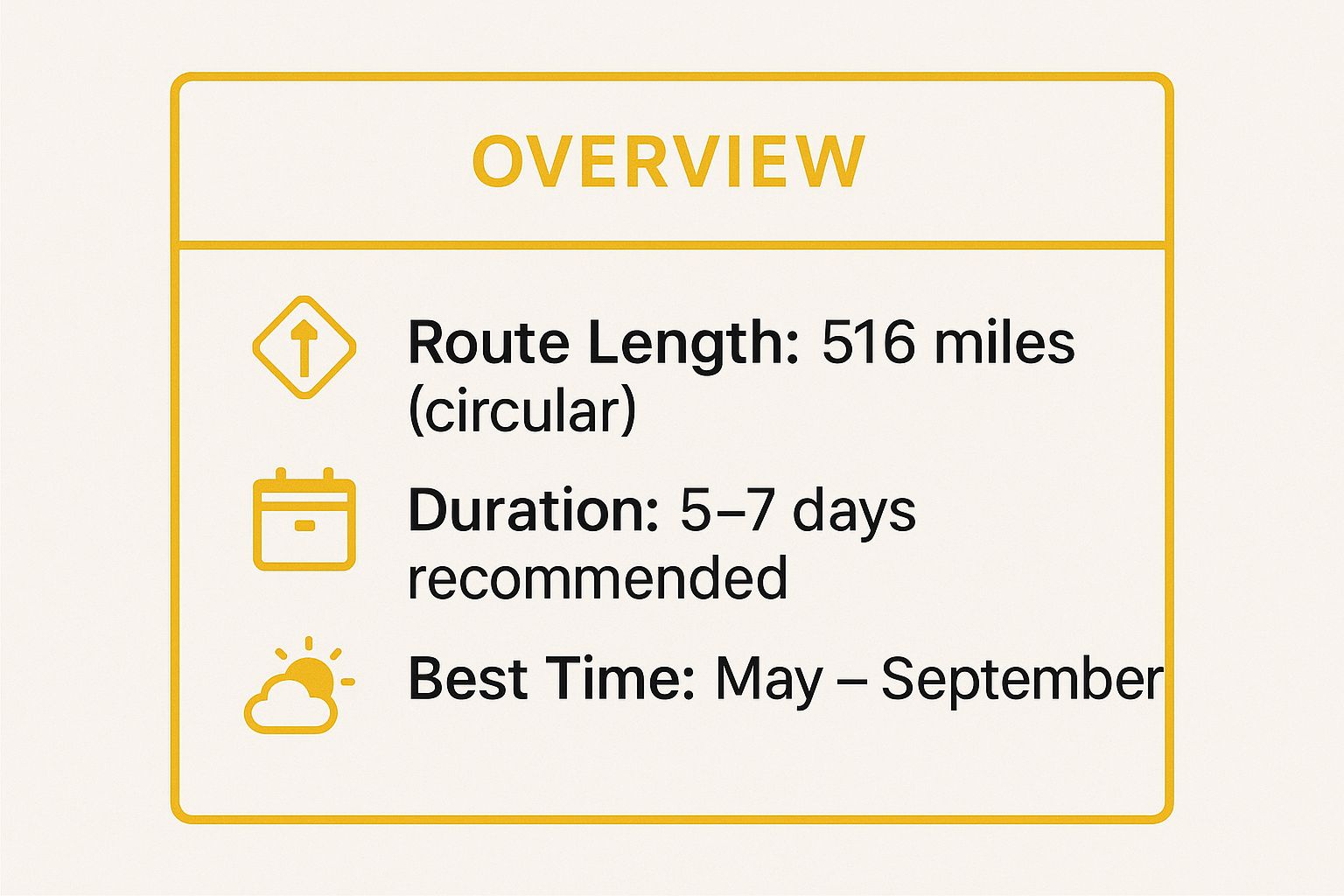
This summary underscores the importance of dedicating sufficient time to truly appreciate the journey rather than simply driving the miles.
Practical Tips for Your Journey
To make the most of your trip, keep these tips in mind:
- Book Ahead: Accommodation, especially during the peak summer months, can be scarce. Plan and book your overnight stays well in advance.
- Fuel Up: Petrol stations are few and far between in the more remote sections. It's a wise policy to top up your tank whenever you see one.
- Be Prepared: Mobile signal is unreliable. Download offline maps and carry midge repellent if travelling between May and September. Also, be mindful of single-track road etiquette and use passing places correctly.
For those looking for a structured way to experience this magnificent route, self-drive tour packages can offer a seamless and well-organised adventure. Discover more about customisable Scottish road trips on btours.com.
2. Cat and Fiddle Road (A537), Peak District
The A537 between Macclesfield and Buxton, known as the Cat and Fiddle Road, is a legendary ribbon of tarmac that slices through the dramatic landscapes of the Peak District. Named after the famous pub at its summit, this route climbs to over 1,600 feet, offering drivers panoramic views across the national park. It's a road built for pure driving enjoyment, with a thrilling sequence of sweeping curves, tight bends, and dramatic elevation changes.
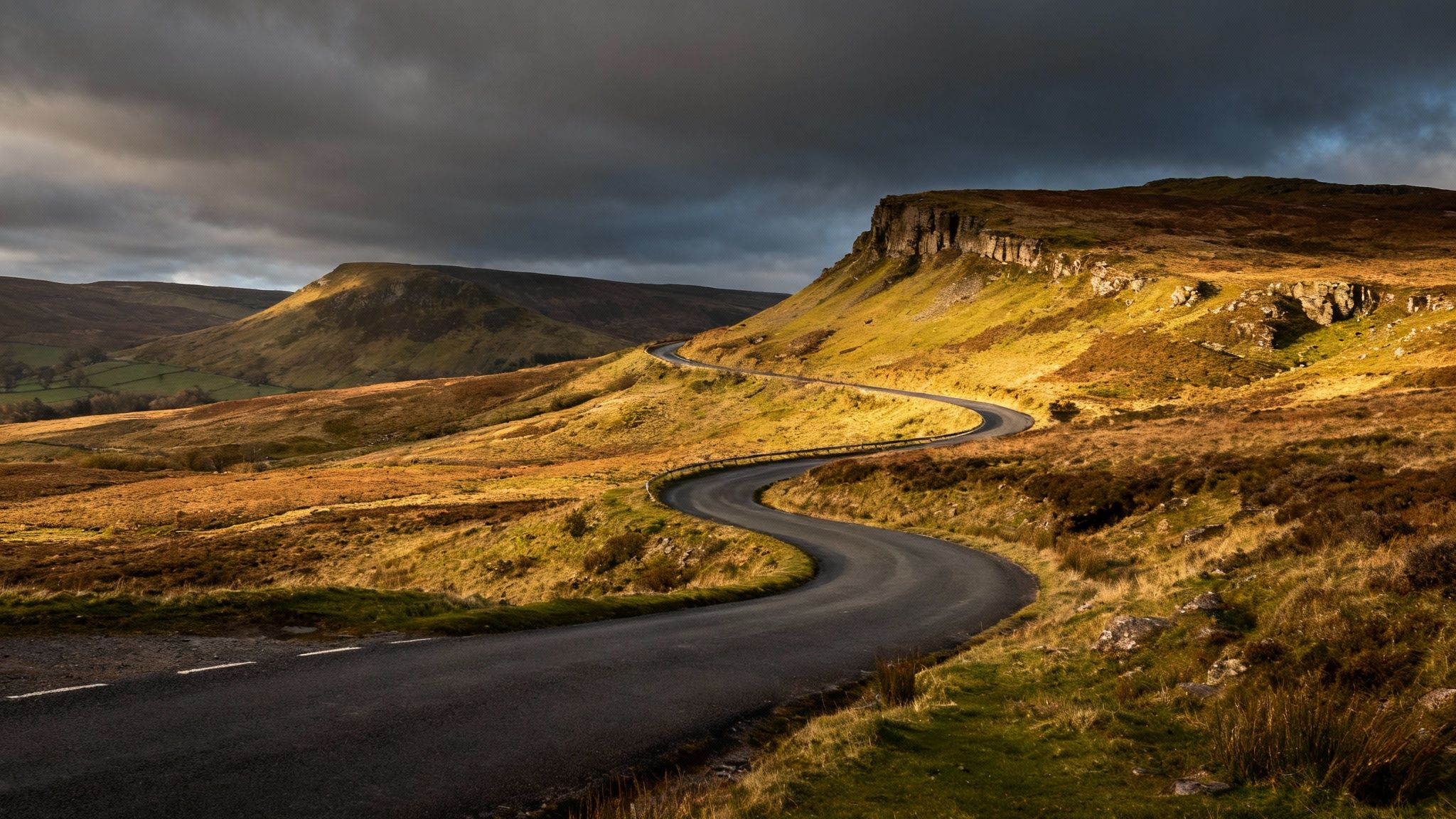
This route is not for the faint-hearted; its challenging nature has cemented its reputation among driving enthusiasts and it's frequently featured in publications like Evo Magazine. While its technical corners demand respect and concentration, the reward is an exhilarating experience that makes it a strong contender for England's best driving road. Its blend of breathtaking scenery and technical challenge offers a compact yet unforgettable journey.
Key Highlights and Essential Stops
While the drive itself is the main event, a few key points enhance the experience:
- The Summit: Reaching the Cat and Fiddle pub marks the highest point of the drive. It’s the perfect spot to pull over, catch your breath, and soak in the vast, windswept moorland views stretching for miles.
- Goyt Valley: Just a short detour from the main route, this stunning valley offers serene reservoirs, woodlands, and walking trails, providing a peaceful contrast to the high-energy drive.
- Buxton: The historic spa town at the eastern end of the route is worth exploring. Admire the Georgian and Victorian architecture, including the magnificent Buxton Opera House and The Crescent.
Practical Tips for Your Journey
To ensure a safe and enjoyable drive, consider these recommendations:
- Check the Weather: The road's high altitude means it is often one of the first in the UK to be closed by snow or ice. Avoid it in foggy or wintry conditions.
- Drive Responsibly: Average-speed cameras are in operation. The road has a poor safety record, so respect the limits and stay alert for sharp, unexpected bends.
- Be Aware of Others: The route is extremely popular with motorcyclists, especially on weekends. Also, be prepared for wandering sheep on the road.
- Plan Your Time: To avoid traffic and get a clear run, aim to drive early on a weekday morning. You can also combine this route with others in the area, like the equally famous Snake Pass (A57).
3. Military Road (B6318), Hadrian's Wall
For a drive that combines sweeping Tarmac with 2,000 years of history, look no further than the B6318, better known as the Military Road. This route stretches across the wild, windswept landscape of Northumberland, running almost parallel to the magnificent Hadrian's Wall, a UNESCO World Heritage Site. Built by General Wade in the 1750s to move troops quickly, the road ironically used stones plundered from the very Roman wall it now shadows, creating a unique link between two distinct eras of British military history.
The B6318 is more than just a road; it’s a journey through time. It rises and falls with the dramatic contours of the land, offering long, straight sections and exhilarating undulations. As you drive, the ancient stone wall appears and disappears alongside you, inviting you to stop and explore the remnants of the Roman Empire's northernmost frontier. This route is perfect for history enthusiasts and those who appreciate raw, unspoilt scenery.
Key Highlights and Essential Stops
The road is a gateway to some of Britain's most significant Roman archaeological sites. Plan to make several stops to fully appreciate the area:
- Housesteads Roman Fort: Perched high on a ridge, this is one of the best-preserved Roman forts in Britain. The panoramic views from the crumbling walls across the Northumberland National Park are simply breathtaking.
- Vindolanda: An active archaeological site and museum, Vindolanda offers a fascinating look into the daily lives of Roman soldiers and their families through incredibly preserved artefacts, including the famous Vindolanda writing tablets.
- Steel Rigg: This location provides access to one of the most iconic and photogenic sections of Hadrian's Wall, as it snakes dramatically over the crags of the Whin Sill. It was also the access point for the famous Sycamore Gap tree.
Practical Tips for Your Journey
To get the most out of your drive along this historic route, consider these recommendations:
- Allow Plenty of Time: While the road itself can be driven in a couple of hours, dedicate a full day to allow for multiple stops at forts and walking sections of the wall.
- Get Your Boots On: The best way to experience the wall is on foot. Wear sturdy walking shoes to explore the often-uneven terrain around the historic sites.
- Check Opening Times: Many of the Roman sites are managed by English Heritage and have seasonal opening hours. Check online in advance to avoid disappointment. Consider membership if you plan to visit several sites.
4. Cotswolds Touring Route
For a quintessential English countryside experience, the Cotswolds Touring Route offers a journey through honey-coloured villages and idyllic rolling hills. Unlike a single defined road, this is a network of winding lanes connecting some of England’s most picturesque settlements. Designated as an Area of Outstanding Natural Beauty, the region spans 800 square miles, presenting a landscape of timeless charm with its distinctive dry-stone walls, ancient wool churches, and perfectly preserved market towns.
This route is less about a single destination and more about the serene journey between them. It’s ideal for drivers who appreciate a slower pace, cultural heritage, and the joy of discovering hidden gems off the beaten path. Meandering through villages like Bourton-on-the-Water and Bibury feels like stepping back in time, making it a strong contender for the most charming, if not the most thrilling, best driving road in the UK.
Key Highlights and Essential Stops
The Cotswolds is dotted with dozens of enchanting villages, but several are truly unmissable:
- Bourton-on-the-Water: Often called the "Venice of the Cotswolds," this village is famed for the River Windrush that flows through its centre, crossed by a series of low-arched stone bridges.
- Bibury: Home to Arlington Row, a fairytale-like line of 17th-century weavers' cottages, this is one of England’s most photographed and iconic village scenes.
- Castle Combe: Frequently voted one of the prettiest villages in the UK, its tranquil streets and historic stone cottages have made it a popular filming location.
Practical Tips for Your Journey
To fully enjoy the idyllic charm of the Cotswolds, consider these practical tips:
- Plan Your Village Visits: The narrow roads mean slow progress. Aim to explore a maximum of two or three villages per day to avoid feeling rushed.
- Travel Midweek: Villages can become very crowded, especially on weekends and during summer. A midweek or off-season visit offers a more peaceful experience.
- Ditch the Car: The best way to explore each village is on foot. Pack comfortable walking shoes to wander the lanes and discover hidden alleyways and artisan shops. Be mindful that large vehicles and motorhomes are ill-suited to many of the minor roads.
Exploring this region is a highlight of many English road trips. To see how it can be integrated into a wider journey, you can discover more about a self-drive tour of Southern England and Wales on btours.com.
5. Loch Lomond & The Trossachs Scenic Route (A82 & A821)
Often called ‘The Highlands in Miniature’, this route offers a perfect introduction to Scotland’s epic landscapes without venturing too far from its central cities. The drive combines the shimmering expanse of Loch Lomond’s western shore along the A82 with the twisting, forested beauty of the A821, known as the Duke’s Pass, through The Trossachs National Park. It’s a journey of contrasts, from wide-open lochside vistas to dense woodland glens.
This route has inspired poets and artists for centuries, most notably Sir Walter Scott, whose work romanticised the region. It’s ideal for drivers seeking a quintessential Scottish experience filled with historic villages, serene lochs, and rugged hills. The combination of water, mountains, and forests creates an ever-changing panorama that solidifies its reputation as one of the best driving roads in the UK.
Key Highlights and Essential Stops
The route is rich with natural beauty and charming stops, but a few are absolutely unmissable:
- Luss: A picturesque conservation village on the shores of Loch Lomond. Its quaint slate cottages, a beautiful church, and a pier offering stunning loch views make it an essential photo stop.
- Duke’s Pass (A821): A legendary driving road that winds through the heart of the Trossachs forest. It’s a thrilling drive with sharp bends and steep gradients, offering breathtaking viewpoints over Loch Achray and the surrounding peaks.
- Loch Katrine: The setting for Sir Walter Scott's famous poem, ‘The Lady of the Lake’. Take a cruise on the historic steamship, the Sir Walter Scott, for a unique perspective of the landscape that captured his imagination.
Practical Tips for Your Journey
To ensure a smooth and enjoyable trip through this stunning national park, consider these tips:
- Start Early: The A82 along Loch Lomond is a major route and can get busy with tour buses and traffic, especially in summer. An early start will help you avoid the crowds.
- Combine the Routes: For the full experience, create a circular route by driving up the A82 and returning via the A821 through the Trossachs.
- Stay Prepared: Midge repellent is essential for summer visits, particularly near water. Also, fuel up in towns like Tarbet or Arrochar before heading into the more remote Trossachs section. Be sure to use designated parking areas to avoid causing congestion on narrow roads.
For travellers looking to combine this scenic drive with an exploration of Scotland's rich gastronomic heritage, a guided tour can provide the perfect blend of scenery and flavour. You can find out more about culinary-focused self-drive tours in Scotland on btours.com.
6. Atlantic Highway (A39), North Devon and Cornwall
Stretching for approximately 150 miles along the rugged coast of South West England, the Atlantic Highway (A39) offers a quintessential English seaside road trip. The route officially runs from Barnstaple in North Devon to Falmouth in Cornwall, hugging a coastline famed for its dramatic cliffs, golden beaches, and charming fishing villages. This drive is a journey through a landscape steeped in myth, artistry, and culinary excellence.
The A39 is more than just a road; it’s a gateway to the heart of Cornish and Devonian culture. It’s perfect for families, surfers, and food lovers seeking a blend of natural beauty and vibrant local life. As the road undulates through green valleys and along exposed clifftops, it provides constant, breathtaking views of the Atlantic Ocean, making it a strong contender for the best driving road in the UK for coastal scenery.
Key Highlights and Essential Stops
The route is dotted with iconic destinations that capture the spirit of the region:
- Tintagel Castle: Immerse yourself in the legend of King Arthur at this dramatic cliff-side ruin. The stunning new footbridge offers spectacular views and connects the medieval castle remains with the mainland.
- Port Isaac: Instantly recognisable to fans of the TV series Doc Martin, this picturesque fishing village features narrow, winding streets and a beautifully preserved harbour. It’s a perfect spot to enjoy fresh seafood.
- Bedruthan Steps: Witness the power of the Atlantic at this spectacular beach, where colossal granite stacks rise from the sand. Access is tide-dependent, but the view from the clifftop path is always breathtaking.
Practical Tips for Your Journey
To ensure a smooth and enjoyable trip along the A39, consider the following advice:
- Timing is Everything: The summer holidays bring severe traffic. For a more relaxed drive with pleasant weather, plan your visit for May, June, or September.
- Book Well in Advance: Accommodation in popular spots like St Ives and Padstow is in high demand, especially during peak season. Secure your bookings months ahead.
- Explore Beyond the A39: Some of the most beautiful coves and villages are found on the smaller B-roads branching off the main route. Don’t be afraid to take a detour.
- Be Prepared: Mobile signal can be patchy in more rural areas, so download offline maps. Always check tide times before heading to a beach to ensure safety and access.
7. Snake Pass (A57), Peak District
The Snake Pass is one of England’s most celebrated and challenging mountain roads, carving a dramatic path across the Pennines between Sheffield and Manchester. This notorious stretch of the A57 climbs to an elevation of over 1,680 feet, winding through the rugged, heather-clad moorlands of the Peak District's Dark Peak. Its name originates not from its twisting nature, but from the emblem of the Duke of Devonshire, which featured on the local Snake Inn.
This route is a rite of passage for driving enthusiasts who appreciate a technical challenge combined with raw, unspoilt scenery. The road demands full concentration with its series of blind crests, tight bends, and steep gradients. Featured in numerous automotive programmes like Top Gear, Snake Pass has cemented its reputation as one of the best driving roads in the UK, offering an exhilarating experience through a wild and atmospheric landscape.
Key Highlights and Essential Stops
While the drive itself is the main event, the surrounding area offers plenty of reasons to stop and explore:
- Ladybower Reservoir: Located at the eastern end of the pass, this vast Y-shaped reservoir is a stunning sight. The surrounding area offers fantastic walking trails and picnic spots, including views of the famous "plugholes" (formally known as shaft spillways).
- Glossop: This historic market town on the western side provides a perfect start or end point for your drive. Its Victorian architecture and welcoming pubs offer a chance to relax and refuel after tackling the pass.
- Peak District National Park: The road cuts through the heart of Britain's first national park. Pull over in one of the designated lay-bys to simply soak in the panoramic views of the desolate, beautiful moorland.
The raw challenge and dramatic setting make this road a firm favourite, but it requires a high degree of driver skill and awareness.
Practical Tips for Your Journey
To safely enjoy Snake Pass, careful preparation is essential:
- Check Before You Travel: The road is highly exposed and is one of the first in the country to close due to snow or bad weather. Always check local traffic reports and the weather forecast before setting off.
- Fuel Up: There are no petrol stations along the main stretch of the pass itself. Ensure you have plenty of fuel before you start your ascent from either Sheffield or Glossop.
- Drive to the Conditions: The road is often narrow and unforgiving. Be vigilant for sheep wandering onto the tarmac, be courteous to other road users, and adjust your speed for the weather, which can change rapidly. Early mornings often provide the quietest conditions for a clear run.
8. Causeway Coastal Route, Northern Ireland
Often cited as one of the world's most spectacular road trips, the Causeway Coastal Route stretches for 120 miles along Northern Ireland's magnificent Antrim coast, from Belfast to Derry~Londonderry. This legendary drive hugs the coastline, offering drivers an ever-changing canvas of dramatic cliffs, charming fishing villages, golden beaches, and ancient castles, firmly establishing its place as a contender for the best driving road in the UK.
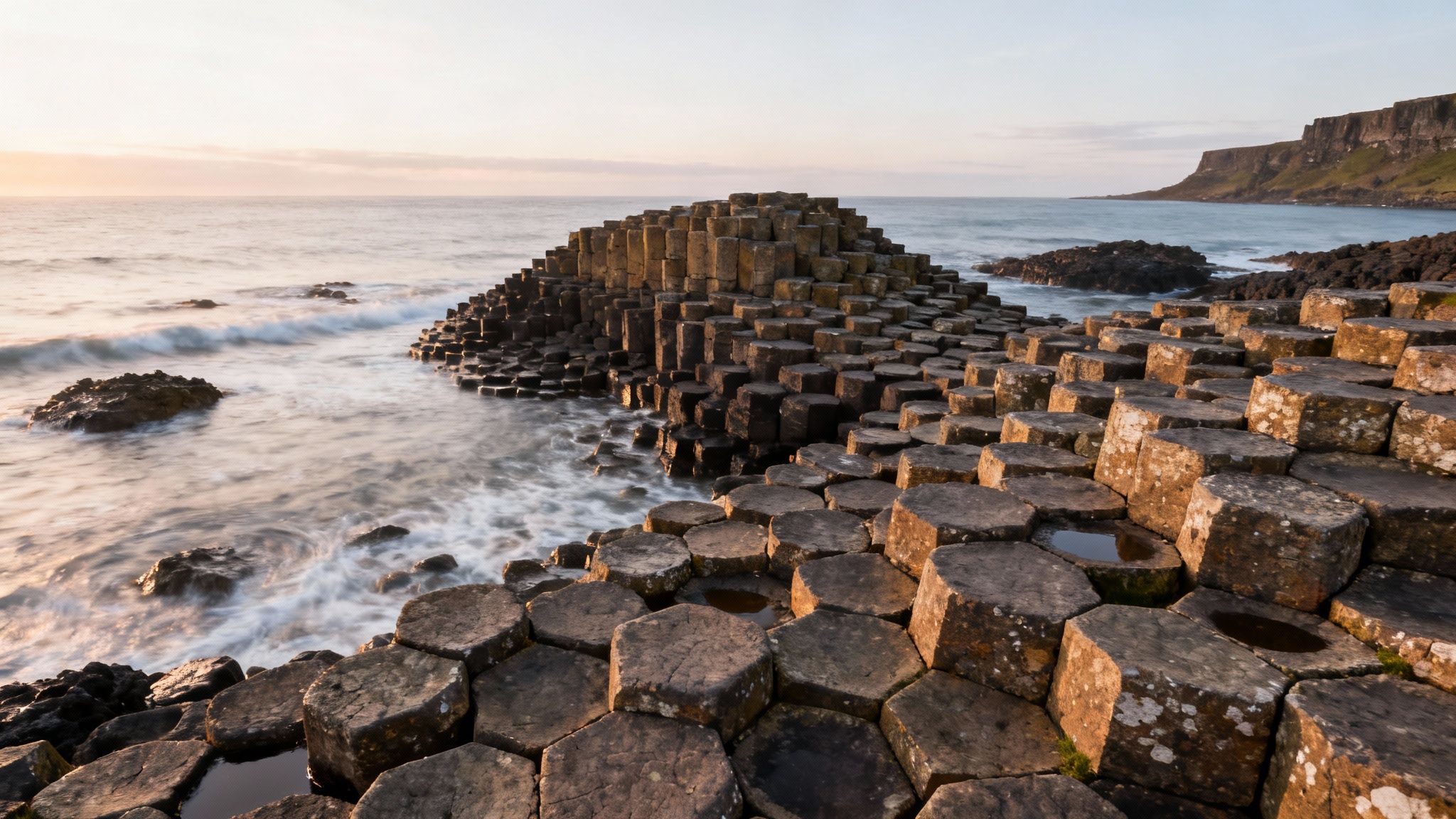
The route is an immersive journey through mythology, geology, and pop culture. It is perfect for travellers seeking a blend of jaw-dropping natural wonders and rich historical tapestry. Whether you’re marvelling at geological marvels or exploring filming locations from the hit series Game of Thrones, this drive provides a unique and unforgettable adventure at every turn.
Key Highlights and Essential Stops
The route is lined with world-famous attractions and hidden gems waiting to be discovered:
- Giant's Causeway: A UNESCO World Heritage Site, this natural wonder consists of around 40,000 interlocking basalt columns, the result of an ancient volcanic eruption. It’s an absolute must-see.
- Carrick-a-Rede Rope Bridge: Test your nerve by crossing this 20-metre-long bridge suspended almost 30 metres above the sea, connecting the mainland to the tiny island of Carrickarede.
- Dunluce Castle: The dramatic, crumbling ruins of this medieval castle teeter on a clifftop, offering a powerful and photogenic glimpse into Ireland's turbulent past.
- The Dark Hedges: Famous as the "Kingsroad" from Game of Thrones, this enchanting tunnel of intertwined beech trees creates a hauntingly beautiful scene.
Practical Tips for Your Journey
To ensure a smooth and enjoyable trip along this iconic coast, consider these practical tips:
- Plan Your Time: While the route can be driven in a day, allow at least two to three days to properly explore the key sites and soak in the atmosphere.
- Book in Advance: Attractions like the Carrick-a-Rede Rope Bridge are incredibly popular. Book your tickets online beforehand to secure a time slot and avoid disappointment.
- Beat the Crowds: Visit the Giant's Causeway early in the morning or later in the evening to experience its magic without the large crowds that gather midday.
- Stay Prepared: The weather can be unpredictable. Pack layers and waterproofs, and always check the forecast before setting out for the day.
This journey is a highlight of any Irish adventure, much like its southern counterpart. For those inspired by grand coastal drives, explore more about the Wild Atlantic Way in Ireland.
Top 8 UK Driving Routes Comparison
| Scenic Route | Implementation Complexity | Resource Requirements | Expected Outcomes | Ideal Use Cases | Key Advantages |
|---|---|---|---|---|---|
| North Coast 500, Scottish Highlands | Moderate: long route, single-track driving | 5-7 days, vehicle suitable for narrow roads, accommodation booking required | Immersive scenic and cultural experience with wildlife spotting | Multi-day road trips exploring Scottish wilderness and culture | Diverse landscapes, rich history, excellent local food and whisky |
| Cat and Fiddle Road (A537), Peak District | Low: short but technically challenging | 30-60 minutes, careful driving on twisting roads | Thrilling short driving experience with panoramic moorland views | Day trips or motorcycle rides seeking technical roads | Exciting driving, accessible from major cities, historic pub stop |
| Military Road (B6318), Hadrian's Wall | Low to moderate: mainly straightforward smooth driving | 1-2 hours driving plus time for historical site visits | Historically rich touring with open landscape views | Historical exploration combined with scenic driving | UNESCO site access, quiet roads, good for all driver skill levels |
| Cotswolds Touring Route | Low: flexible routes through villages and lanes | 2-7 days, planning recommended for accommodation and navigation | Quaint village visits and gentle countryside touring | Leisurely drives for sightseeing, shopping, and heritage | Beautiful preserved villages, rich culture, family-friendly |
| Loch Lomond & The Trossachs Scenic Route (A82 & A821) | Moderate: mix of main roads and narrow passes | 2-3 days, suitable vehicle for narrow roads | Picturesque loch and mountain scenery with outdoor activities | Scenic short touring near Glasgow with nature and history | Spectacular scenery, good facilities, easy access from city |
| Atlantic Highway (A39), North Devon and Cornwall | Moderate: coastal driving with some narrow lanes | 5-7 days, accommodation booking advised | Coastal scenery with cultural, historical, and outdoor experiences | Extended coastal touring, food and activity focused trips | Dramatic coast, surfing hotspots, rich legends and seafood |
| Snake Pass (A57), Peak District | Moderate: challenging mountain road, steep and narrow | 45-90 minutes, experienced drivers recommended | Exciting technical drive through dramatic moorland | Enthusiast drivers seeking challenging and scenic mountain roads | Thrilling driving, dramatic views, popular among enthusiasts |
| Causeway Coastal Route, Northern Ireland | Moderate: well-maintained with some narrow village sections | 2-3 days, parking and timing planning needed | World-class coastal views with cultural and pop culture highlights | Multi-day scenic and cultural road trips | Stunning coast, UNESCO site, Game of Thrones landmarks, excellent facilities |
Your Ultimate UK Road Trip Awaits
From the rugged, windswept grandeur of Scotland's North Coast 500 to the dramatic clifftop vistas of Northern Ireland's Causeway Coastal Route, the United Kingdom presents a remarkable tapestry of landscapes best explored from behind the wheel. We've journeyed through the challenging twists of the Peak District's Snake Pass and the serene, honey-stoned villages of the Cotswolds, showcasing that a truly great drive is about more than just the road itself; it's an immersive experience that engages all the senses. Each route offers a unique narrative, whether it's the ancient history etched alongside Hadrian's Wall on the Military Road or the untamed coastal beauty of the Atlantic Highway.
The key takeaway from this exploration is diversity. There isn't a single "best driving road uk," but rather a perfect road for every mood, season, and interest. For the thrill-seeker, the technical precision required for the Cat and Fiddle is unparalleled. For the soul-searcher, the tranquil beauty of Loch Lomond and The Trossachs provides a serene escape. Your ideal journey depends entirely on what you seek: adventure, history, tranquillity, or a combination of all three.
Turning Inspiration into Action
Embarking on one of these iconic drives requires more than just a full tank of petrol; it demands thoughtful preparation to transform a good trip into an unforgettable one.
- Plan Strategically, Drive Spontaneously: Research your primary points of interest, from historic castles to recommended pubs, but build flexibility into your schedule. The most memorable moments often happen in unplanned detours and spontaneous stops.
- Book Your Base: Especially during peak season, popular spots along routes like the NC500 or the Cotswolds see accommodation fill up months in advance. Secure your overnight stays to avoid disappointment and ensure you have a comfortable base from which to explore.
- Respect the Road and the Locals: Many of these spectacular routes cut through delicate ecosystems and quiet communities. Adhere to speed limits, use passing places correctly on single-track roads, and be a considerate visitor. Your responsible driving ensures these areas remain beautiful and welcoming for everyone.
Ultimately, the best driving road in the UK is the one that captivates you, the one that encourages you to pull over just to admire the view, and the one that leaves you with stories to tell for years to come. Whether you conquer one of these legendary routes or design a grand tour linking several together, the open road is your invitation to discover the profound beauty and rich heritage of the British Isles. The journey is yours to define.
Ready to experience the ultimate UK driving adventure without the stress of planning? Explore the curated self-drive itineraries from BTOURS, where we combine iconic routes with hand-picked accommodations and can't-miss experiences, ensuring your journey is as seamless as it is memorable. Visit BTOURS to find your perfect road trip today.

